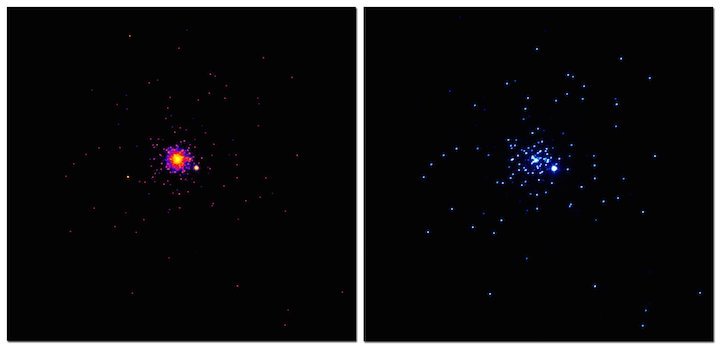5.12.2017

Near-UV (left) and Far-UV (right) images of the Globular Cluster NGC 1851, taken by UVIT onboard AstroSat.
The FUV image shows only the hottest stars in the cluster. All colours are artificial. Image credit: Annapurni Subramaniam et al.
NGC 1851 is a Globular Cluster which is almost 40000 light years away from us, in the southern constellation of Columba, near Canis Major. A Globular Cluster is a group of hundreds of thousands of stars tightly bound together by their own gravity. All the stars in these spherical clusters orbit around the centre of our galaxy together. NGC 1851, or Caldwell 73, is one such cluster, visible in a moderate telescope at a magnitude of 7.3, with a size that is a third of the full moon. It was discovered by James Dunlop from Australia in 1826.
The stars in a Globular Cluster are usually born together, and hence share similar properties. However, NGC 1851 is one of the few clusters where two distinct types of stars with different properties seem to co-exist! Many individual stars in this object have been studied before with the Hubble Space Telescope (HST), but good ultraviolet images were needed to understand this mystery better. This prompted a group of 18 astronomers, including 12 from India, to use the UVIT on board the AstroSat. They imaged this cluster in the Near and Far ultraviolet wavebands far better than earlier attempts with other telescopes.
The superior resolution of AstroSat allowed them, for the first time, to measure the ultraviolet properties of individual stars in the inner crowded region of the cluster. Using this data, they could show that NGC 1851 does indeed have two distinct families of stars within it, which still retain their separate histories. This tells us that NGC 1851 was probably formed when two smaller clusters merged together some time in the past
+++
The Horizontal Branch population of NGC 1851 as revealed by the Ultra-violet Imaging Telescope (UVIT)
We present the UV photometry of the globular cluster NGC 1851 using images acquired with the Ultra-violet Imaging Telescope (UVIT) onboard the ASTROSAT satellite. PSF-fitting photometric data derived from images in two far-UV (FUV) filters and one near-UV (NUV) filter are used to construct color-magnitude diagrams (CMD), in combination with HST and ground-based optical photometry. In the FUV, we detect only the bluest part of the cluster horizontal branch (HB); in the NUV, we detect the full extent of the HB, including the red HB, blue HB and a small number of RR Lyrae stars. UV variability was detected in 18 RR Lyrae stars, and 3 new variables were also detected in the central region. The UV/optical CMDs are then compared with isochrones of different age and metallicity (generated using Padova and BaSTI models) and synthetic HB (using helium enhanced Y2 models). We are able to identify two populations among the HB stars, which are found to have either an age range of 10-12~Gyr, or a range in Yini of 0.23 - 0.28, for a metallicity of [Fe/H] =−1.2 to −1.3. These estimations from the UV CMDs are consistent with those from optical studies. The almost complete sample of the HB stars tend to show a marginal difference in spatial/azimuthal distribution among the blue and red HB stars. This study thus show cases the capability of UVIT, with its excellent resolution and large field of view, to study the hot stellar population in Galactic globular clusters.
Quelle: ISRO
